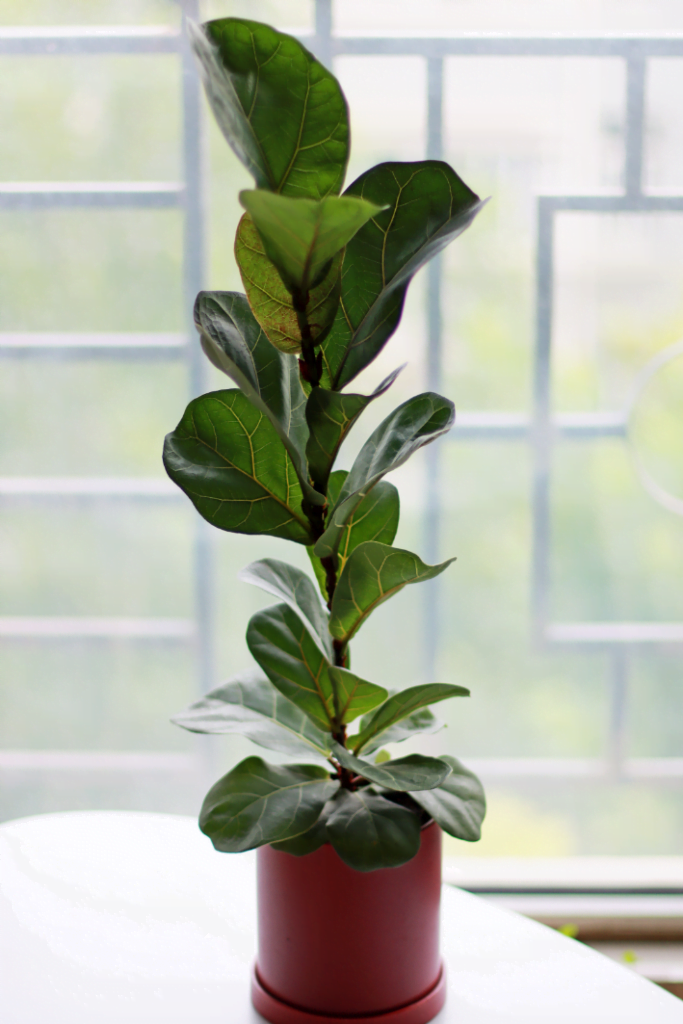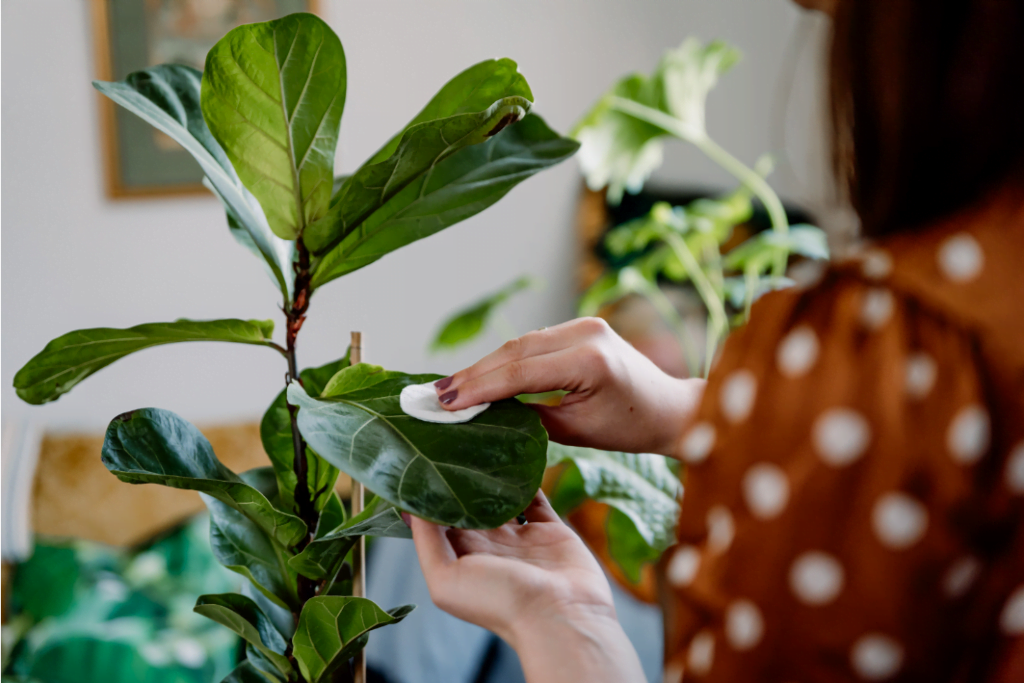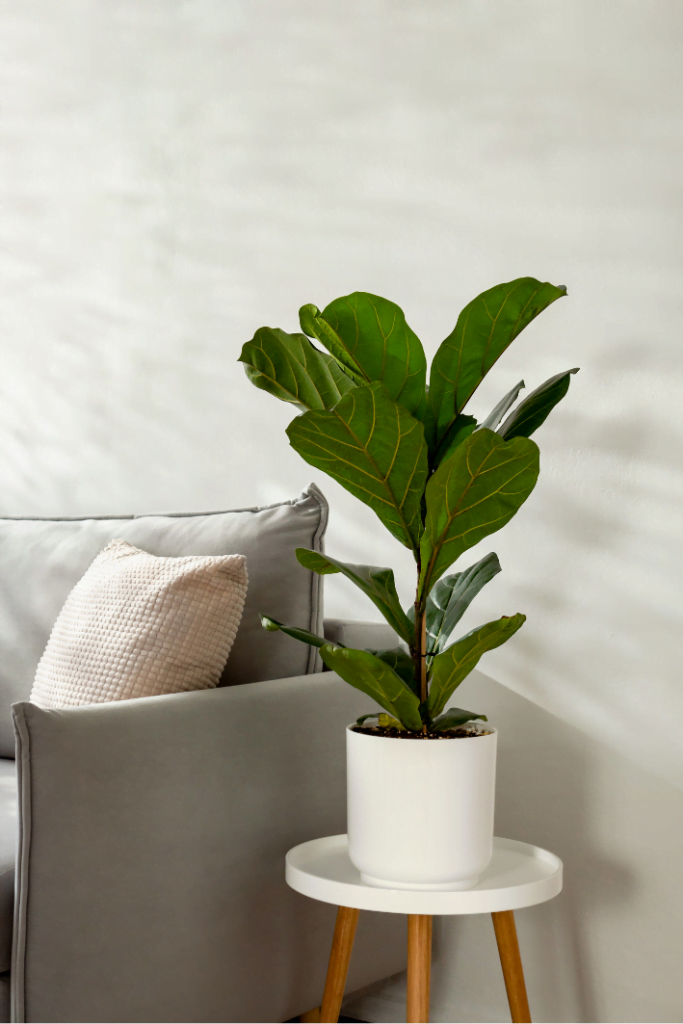
I have ten Fiddle-Leaf trees, and over the past 11 years, I’ve gained comprehensive knowledge and experience in caring for them. In this blog, I aim to share detailed insights and information about caring for Fiddle-Leaf trees, drawing from my extensive experience. I believe sharing my experience will greatly benefit you in nurturing and maintaining these trees.
Now let’s know about the scientific name and content of this plant
The botanical name of this tree is Ficus Lyrata. Type: Broadleaf Evergreen. The height of a mature tree is 11 feet outdoors and about 10-11 feet inside the house. This plant generally requires loamy, moist, well-draining soil and snowballs. Bloom time is scarce outside its native area; the flower color is insignificant.
How I take care of this tree

- I use very little water on this plant, which doesn’t mean I don’t water it, but I only water it when the soil at its base is slight
- Excess sunlight is very damaging to this plant, so I place it in a spot that will receive just enough light.
- Keeping this plant in an excessively cold place will damage it, so I don’t keep it in such conditions, and neither should you. Maintaining a moderate temperature will keep your plant very fresh.
- Moisture or mist is very beneficial for this plant, so you can mist it once a week.
- Every week, you can trim the dead or yellow leaves of this tree with scissors and clean the leaves with a wet cloth. This will make your tree look much more beautiful and be very beneficial for photosynthesis
- If you want to keep this plant indoors only, you can maintain it at a height of 6-7 feet. Trim the top of the main stem as I have done; it will look great and be easy to maintain.
- This plant does not need any fertilizer during winter, but you can use commercially available fertilizers specially formulated for fiddle leaf figs during summer.
- Before trimming the leaves of this tree, be sure to pull them by hand. If they come off easily, then there is no need to cut them. However, regular pruning is very beneficial for this tree. Of course, dead or yellow leaves should be pruned.
- ChatGPTStem cuttings can easily propagate this plant. First, the cuttings should be kept in a clean glass water container, and the water should be changed regularly. When you notice that the color of the water has changed, change it. After a few days, you will notice white spots around the part of the tree that is submerged in water. After a few more days, the tree’s roots will emerge from these spots. Once the roots have appeared, you can plant the tree in a pot. Be sure to use loamy, moist, well-draining soil in the pot.
- This tree doesn’t usually suffer from serious diseases or pests, as my trees have never had any diseases. However, spiders may make their nests in this tree, leading to damage to the leaves, so be cautious. If any fungus is noticed on your tree, you can quickly spray a fungicide and insecticide to eliminate the issue. Also, ensure your tree is receiving regular light. If not, please make arrangements to provide adequate light.
How to Grow Fiddle Leaf
Choosing the Right Plant
Pick a strong trunk and brilliant, shiny leaves on a solid plant while picking a Fiddle Leaf Fig. Avoid plants that have earthy colored patches, hanging foliage, or bug harm. It’s likewise vital to consider the plant’s size; albeit a bigger plant could say something, it will likewise require more space and consideration.
Ideal Location and Light Requirements
The best light for fiddle leaf figs is solid aberrant light. Your plant will benefit enormously from separated daylight whenever put close to a window; direct daylight, then again, could consume the leaves. While windows that point toward the east or west with sheer shades function admirably, windows that point toward the south or west are similarly appropriate. Turn it habitually to keep up with even turn of events and prevent the plant from leaning toward the light source.
Temperature and Humidity
Warm, muggy circumstances are liked by these tropical plants. Keep a temperature scope of 60-75°F (16-24°C). Keep your Fiddle Leaf Fig away from radiators, forced air system vents, and drafts as these wellsprings of unexpected temperature variances can pressure the plant. It is invaluable to keep the stickiness level at around half. Have a go at adding a plate of water near the plant or utilizing a humidifier if your home is dry, particularly in the colder time of year.
Watering
It’s fundamental to have a dependable water framework for your Fiddle Leaf Fig. At the point when the main a couple of creeps of soil feel dry to the touch, water your plant. Keep away from over-watering as this would prompt the disintegration of the roots. While watering the pot, try to lower the soil until the water arrives at the pot’s base. Around then, permit any leftover water to deplete. Ensure your pot has leakage openings to keep water from pooling at the base.
Soil and Potting
Fiddle Leaf Figs love well-exhausting soil. With an unrivaled planning mix that incorporates peat, perlite, and pine bark, it performs perfectly. Moreover, you can incorporate coarse sand to work on squander. By and large, expected to each one to two years or when the plant grows out of its pot. Pick a holder that is one to two inches more extensive than the past one. Reporting is best finished in the spring or summer, as this is the plant’s dynamic creating season.
Fertilizing
During the developing season (spring and summer), feed your Fiddle Leaf Fig once every four to roughly one and a half months utilizing suitable, water-solvent compost. The N-P-K proportion of the ideal fertilizer is 3-1-2. Decrease or stop treatment as the plant’s advancement fades in the fall and winter.
Pruning and Shaping
Pruning keeps up with solid development and assists you with keeping your Fiddle With Leafing Fig at the right size and structure. Eliminate any harmed or dead leaves and diminish any thin development to advance a more complete plant. Prune the plant if it ends up being excessively tall for your space; this will likewise help manage its level. Continuously utilize spotless, sharp pruning shears to diminish the opportunity for tainting and give clean cuts.
Cleaning the Leaves
The fiddler crab’s huge passes on can assemble waste, which can obstruct photosynthesis. To keep up with the leaves sparkling and clean, wipe them often with a wet fabric. This won’t just work on the plant’s presence yet in addition empower it to assimilate considerably more light.
Pest Control
The most notable vermin that influence fiddler crabs are coarse bugs, scale bugs, and parasitic bug species. Look at the plant consistently for indications of bug invasion, for example, minuscule cobwebs, tacky gathering, and apparent bugs. On the off chance that you see bugs, utilize insecticidal cleaner or neem oil for the plant as per the item’s guidelines. Isolating the plant from different plants until the intrusion is settled is likewise a reasonable move.
Addressing Common Issues
- Brown Spots: A contagious invasion, under-watering, or over-watering might be the reason for this. Investigate the plant’s seepage and survey your watering plan. Assuming that there might be parasitic contamination, eliminate the distressed leaves and apply a fungicide.
- Drooping Leaves: regularly a sign of a lack of abundance or water. Assess your water system timetable and make vital changes.
- Leaf Drop: Varieties in moistness, light, or temperature can all add to unexpected leaf drop. Intend to keep a consistent climate for the plant and cease moving it frequently.
Propagation
Leaf Fiddle Stem cuttings are a valuable instrument for duplicating figs. Ensure there are a couple of leaves associated when you take a 6 to 8-inch clip from the highest point of the plant. Submerge the cutting in water or a dirt combination that channels appropriately. While using water, frequently change it to stay away from stagnation. After the cutting has roots, you can establish it in the ground.
Seasonal Care
- Spring and summer: This is the time of dynamic development. Support the recurrence of your watering and prepare now and again. Another choice is to take the plant outside and spot it in an obscure region, permitting it to become used to the expanded light bit by bit.
- Fall and winter: This is the slowest development month. Scale back the water system and stop preparing. Ensure the plant is safeguarded from heat sources and cold blasts.
Emotional and Aesthetic Benefits
Past their requirement for actual support, Fiddle Leaf Figs have significant mental and ornamental benefits. Their tremendous, verdant leaves can quiet and bring a feeling of nature into any inside setting. A Fiddle Leaf Fig’s upkeep can likewise be satisfying, providing you with pride as you watch out for the plant.
Troubleshooting
- Yellow Leaves: This might show insufficient waste or over-watering. Ensure the plant isn’t lowered in water and adjust the recurrence of watering.
- Leggy Growth: shows that there is deficient light for the plant. Shift it to a more brilliant region; however, keep it out of direct sunlight. Shows that there is deficient light for the plant. Shift it to a more brilliant region; however, keep it out of direct daylight.
- Stunted Growth: might be gotten on by a lack of supplements, light, or root-bound conditions. Confirm that the plant is getting sufficient light and supplements, and decide if it should be reported.
How to decorate the interior of the house with this tree

- If you have plenty of natural light in your house, you can place this tree at the entrance so that when you enter, you’ll be greeted by natural light, which can help relieve the tiredness of the day.
- If you keep this tree in your bedroom or dining room, the beauty of the room or dining area will greatly increase.
- If you aim to provide a natural and beautiful environment for all the people who visit your house, consider placing a Fiddle Leaf Fig in a corner of your guest room. It will greatly enhance the ambiance of your house.
So, in conclusion, I would like to emphasize that the Fiddle Leaf Fig is a wonderful tree that significantly enhances the beauty of any home. Having trees indoors brings a touch of natural warmth to the living space. If you appreciate trees, consider adding a Fiddle Leaf Fig along with other varieties. In the discussion above, I have shared my personal experience to highlight its benefits.

